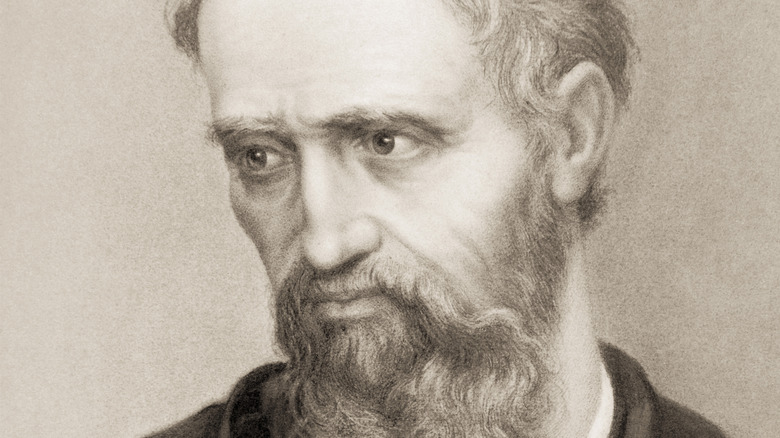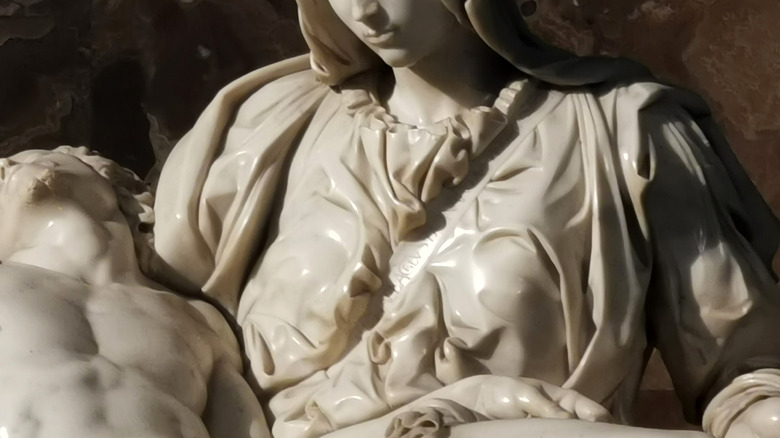The Only Piece Of Art Michelangelo Ever Signed
By 1498, the young artist Michelangelo di Lodovico Buonarroti Simoni had already begun to make his mark in Florence, where he was from, but hadn't yet broken through in Rome. He'd made only one piece there — a sculpture of Bacchus, the Roman god of wine — when the French diplomat and cardinal Jean de Bilhères Lagraulas hired the 22-year-old for the biggest commission he'd ever had thus far in his career, according to "Michelangelo's Vatican Pietà and its Afterlives" and Britannica.
The cardinal wanted Michelangelo to create a funerary monument in St. Peter's Basilica in Vatican City for him. This was a huge opportunity for the artist to take his career to the next level and show the world just what he was capable of. Bilhères wanted the subject of the sculpture to be a pieta, an image of Mary holding her dead son Jesus after his crucifixion. He also wanted it completed in a year and to be "the most beautiful work of marble to be found in all of Rome." Michelangelo fell short of his contract in regard to the timetable but definitely came through with Bilhères' second demand. And for the first and last time in his hugely successful career — a decision that would become controversial — Michelangelo signed his work.
A huge success
From the moment Michelangelo unveiled his sculpture in the summer of 1500 (after his patron who commissioned the work had already died) the Roman elite hailed it as a masterpiece, per "Michelangelo's Vatican Pietà and its Afterlives." It was a sensation. Michelangelo had created from one solid block of marble a heartbreaking scene of Mary, whom he portrayed as a young woman, cradling her dead son in her lap. Antonio Billi, a writer and contemporary of the artist, said that the sculpture "stupefied all the intelligentsia," per "Renaissance Rivals: Michelangelo, Leonardo, Raphael, Titian."
There was one highly visible element of the Pieta that "brought him fame that verged on infamy" according to "The Cults of Raphael and Michelangelo: Artistic Sainthood and Memorials as a Second Life." He had carved a sash running across Mary's chest with a Latin inscription, which translates to "Michelangelo Buonarroti the Florentine is making." The unusual tense of the word "making" harks back to the ancient Greek artists that Michelangelo revered who believed that no work of art was ever truly complete or perfect, per "Michelangelo's Vatican Pietà and its Afterlives."
Why did he sign it?
There are several possible explanations for why Michelangelo chose this one work to sign. At the time, it hadn't yet become common for artists to sign their work, especially when it was a commissioned sculpture, but it wasn't unheard of, according to "Renaissance Rivals." This was Michelangelo's first big commission and he may have simply wanted to get his name out there to help establish his reputation, per The Electronic Sixteenth Century Journal. But there are others who believe it was a matter of making sure no one else took credit for his creation.
Vasari, his first biographer, told an apocryphal story about Michelangelo overhearing some viewers looking at the Pieta and attributing it to another artist, which inspired him to add his signature at the last minute, per "Michelangelo: A Life in Six Masterpieces." Scholars tend not to believe this story since the sash appears to have been planned by the artist from the start. Whatever the reason for Michelangelo adding his signature to the Pieta, it worked in his favor. His next big commission came shortly thereafter when he got the chance to create his masterpiece, David, per Britannica.


